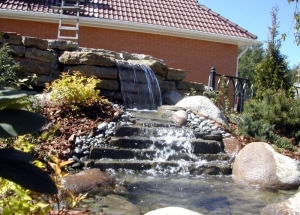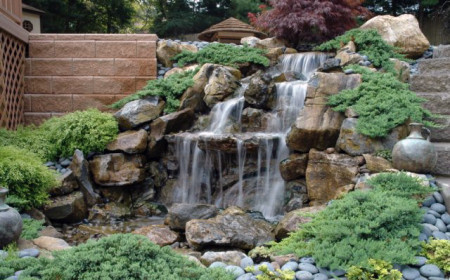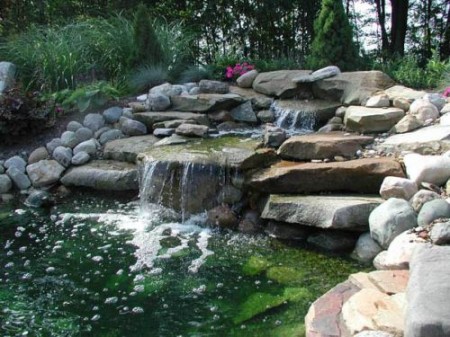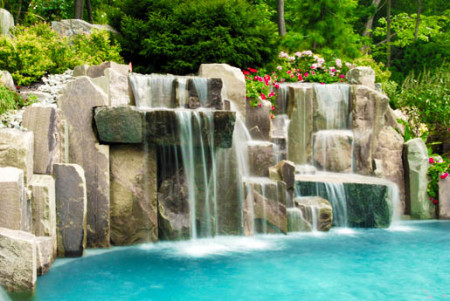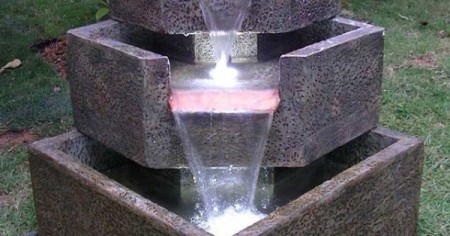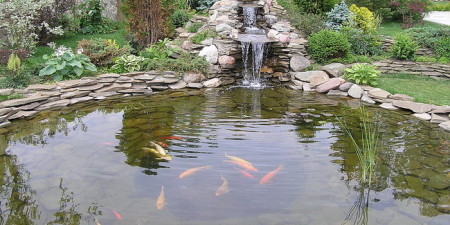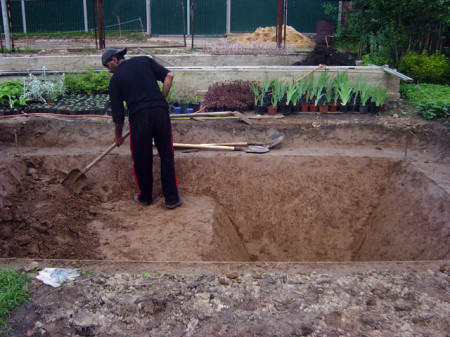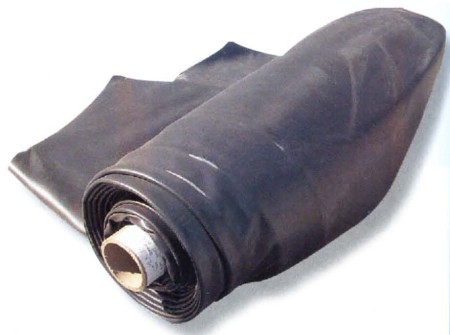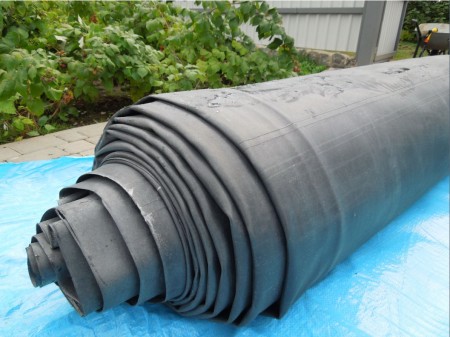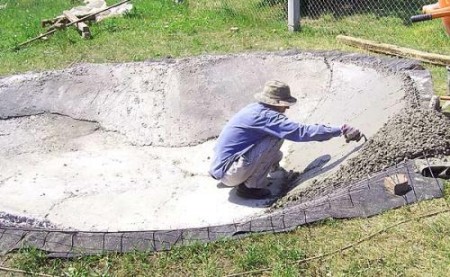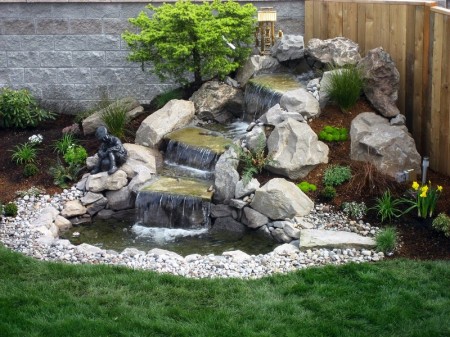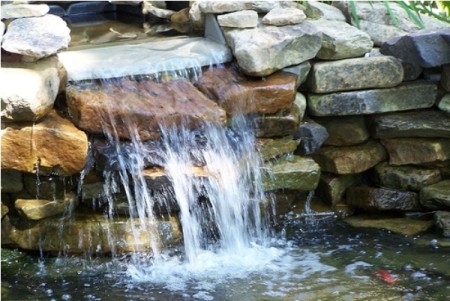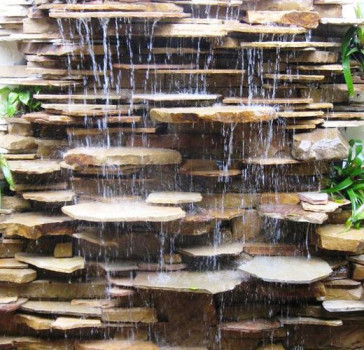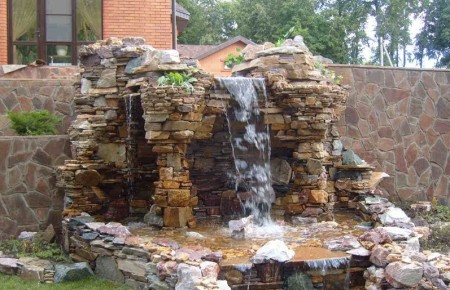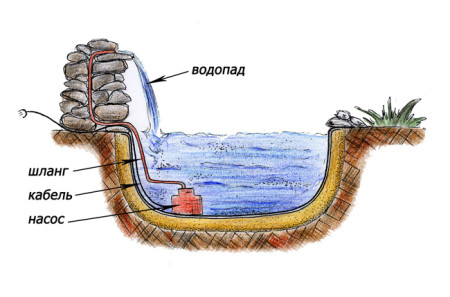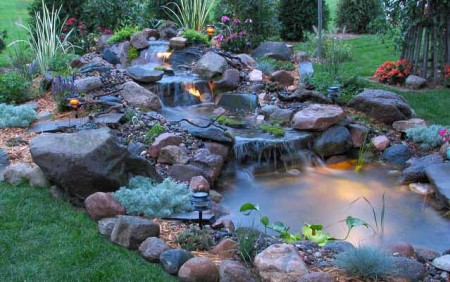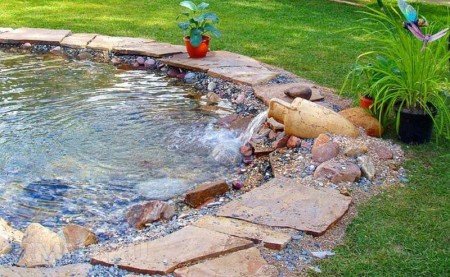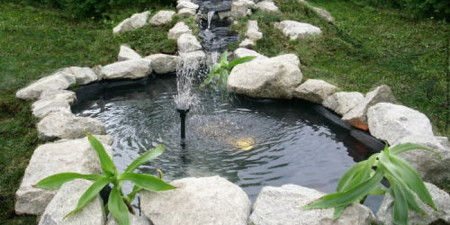Own waterfall in the garden, at the cottage or your own country plot is a dream that many think is something unrealizable. However, in fact it is quite simple and easy to implement. A real decorative waterfall can be made by yourself during one weekend. The main thing is to have at least some building skills. And the material below will help you choose the right materials and technology. Just a few days of work in your own fun in the fresh air - and your own waterfall will please your family members for at least one season.
Content
What is a decorative waterfall
If there is already an artificial pond in your garden or in the garden - a small pool or a pond, the task is much simpler. Artificial waterfalls include three components: the elevation with which water will escape, the tanks where it will be assembled, and a waterfall pump ensuring uninterrupted circulation of the liquid. If there is no pond, then, before making a waterfall, you need to find a suitable place for a pond or pool, and determine its shape. As for the form, everything depends on personal preferences and tastes.
When choosing a form, it does not hurt to remember that nature does not use straight lines. Therefore, the irregular shape of the reservoir will look more natural.
However, if you prefer the right geometric forms, you can safely implement your plans, as everything is done, as they say, "for yourself.", Especially since there are a lot of similar solutions - for example, geometrically correct water bodies with a waterfall perfectly fit in design in the style of "high-tech" and "modern".
And if your site is decorated in the style of such creative negligence, then it will undoubtedly be decorated with a waterfall made in the same style. In this case, you can use almost any construction materials: trimming old pipes, pots, shards, stones, buckets, used plumbing, etc. You can even make a waterfall from a rough and unattractive at first glance piles of stones, and in the evening twilight listen to the quiet murmur of water - what else is needed for relaxation and relaxation?
Even at the design stage, you need to decide whether you will plant a plant in the pond and keep any living creatures there. Decorative waterfall is very suitable for keeping fish and various aquatic plants: constantly moving water is enriched with oxygen, and the fish feels much more comfortable than in standing water.
In addition, the waterfall maintains a constant comfortable water temperature, which is especially important in hot weather. However, on the other hand, for some species of plants, for example, on water lilies, rapidly moving water does not have the best effect.
Waterfall with their own hands step by step instruction
digging a pit under the pond
When the shape of the pond was determined not only in the head, but also on paper, you can start preparing the pit. To begin with, the area is cleaned of debris, and the top layer of the turf is removed. Then, on the cleaned surface, the shape of the future reservoir is drawn.
For this, the surface must be leveled first - ideally it should be absolutely flat. After that, outline the pit. For this you can use wooden pegs and twine. If a ready plastic container is used for the pond, its contours are simply outlined on the ground.
After that, you can arm with bayonet and shovel and start digging. Brought out of the excavation of the ground does not need to be thrown as horrible in all directions, but neatly collected somewhere in one place - it is still useful. The excavated land must be immediately cleaned of debris, roots, pebbles and other debris, if any, it will be easier and more pleasant to work with a clean ground.
When digging the excavation from the walls, of course, the earth will constantly be showered. If it hinders you, wet the walls with water and tamp them with your hands. When the pit is dug to the required depth, you need to dig about another 15-20 centimeters and wake up the bottom with a fine clean (preferably without clay) sand that needs to be densely packed.
waterproofing of the excavation
If the pond uses ready capacity, then this question, of course, should not be considered. Otherwise, you can not do without good waterproofing, otherwise the pond will soon dry up. And your garden waterfall will last for many years only if the technology is properly observed. The insulation options for a garden waterfall can be several:
• PVC film.
• Butyl rubber film.
• EPDM film.
• Concrete.
Let's consider each of the options in more detail. So, the PVC film is the most common version of the waterproofing of the future pond. PVC can last a fairly solid time - up to 15 years. Another advantage of this material is the price.
The drawbacks include the fact that a garden fountain with such a waterproofing requires constant careful care. Water from the reservoir for the winter will have to drain, otherwise ice can damage the film.
The butyl rubber film was specially developed as a waterproofing of the bottom and walls of decorative pools and ponds. She is absolutely not afraid of frost, and is able to withstand negative temperatures below 40 degrees Celsius. Butyl rubber film is elastic, and has a huge margin of safety. Of course, the price for this material is also approximately 2,000 rubles for one running meter. To the cost of a meter of film, you still need to add the cost of components (connectors for film strips, special accessories for the pump, etc.).
EPDM film - synthetic rubber. Modern material, which has similar technical characteristics to butyl rubber. The material has a truly unique elasticity, as it has a porous structure and convenient installation.
EPDM film refers to premium materials, its cost is from 3500 rubles per running meter. Butyl rubber and synthetic rubber can be purchased in several thicknesses of sheets: 0.75 mm, 1.125 mm, and 1.5 mm. Naturally, the thickest film is the most durable and durable, the only drawback is that it is inconvenient to use to isolate water bodies of complex shape.
Before you start laying flexible waterproofing, the walls and the bottom of the pit should be cleaned as carefully as possible from objects that can damage sheets of film or rubber - stones, plant roots and other debris. To protect the waterproofing from damage, it is best to lay it on some protective material. You can use geotextiles, cardboard, or even old linoleum, newspapers, etc.
One of the most laborious, but at the same time, reliable options - concreting. If you decide to make a pond, as they say, for centuries, you need to thoroughly prepare: cover the bottom of the foundation pit with a protective layer (waterproofing + sand cushion). As a waterproofing agent, simple polyethylene can be used. Next, you need to make a frame of reinforcement with a cross section of 10 mm, set the formwork and fill the bottom first, and then the walls (after the bottom of the foundation hole has completely hardened) with concrete of grade M300 and above. The fraction of crushed stone is from 5 to 20 mm. Then it remains to wait until the concrete on the walls is fully seized, after which you can proceed to decorating the walls and decorating the banks of the reservoir.
Several important points: before you begin laying a flexible waterproofing material (EPDM, butyl rubber sheet), you need to let it lie in direct sunlight for about 15 minutes. After that, the film will become much more flexible, and it will be easier to mount it. Once the waterproofing is installed, the pond immediately needs to start up water to make sure there are no leaks, unevennesses and other damages and defects.
How to make a waterfall with your own hands: choose the height and configuration of the cascades
Most decorative waterfalls do not exceed 1.5 meters. Yes, this is not Victoria Falls, but the pump will not work "pesky", and will cope with its work, as it should. If you want to make a waterfall with several ledges, then for the masonry it is easiest to use sandstone - it is very easy to process, and it looks as natural as possible. Cascades of the waterfall begin to be laid from the bottom. The first tier is made even, and the next - depending on personal preferences and the chosen project.
Some tips for decorating a waterfall:
The water wall-mirror - the stones from which the water will flow, must be completely flat, flat and neat.
Falling separately jets - a waterfall should contain ledges with furrows. The surface of the stones must be indented and uneven.
Smoothly and slowly flowing water - need stones with small depressions in the middle, forming something like a bowl, or flat, exposed strictly horizontally. Water will gradually fill the depressions and flow down smoothly.
A powerful stream of water, splashing against the lower tier - water must flow between two closely spaced stones. The height of this waterfall should be at least one meter.
Forming tiers for a waterfall, stones are best connected with each other using a construction foam or a strong cement mortar. To prevent water from spreading too much, you can make skirts along the edges.
A little advice: when gluing stones with mounting foam, its remains can protrude along the edges of the seam. To hide this drawback, immediately after the application of foam, a fresh seam should be sprinkled with fine sand - it will be firmly adhered, and the seam will look beautiful and natural.
Choosing a pump
The pump is the "heart" of an artificial waterfall, because the water itself does not flow upward. If the waterfall has a height of about one and a half meters, then it is enough for him to use a pump with a power of about 70 watts. Of course, the higher the height of the waterfall, the more powerful the pump is needed. It is installed on the bottom of an artificial reservoir in such a way that neither the pump itself nor the cables leading to it are visible. In the pump for the waterfall there are two holes: one enters the water, the other is pushed out under pressure.
The second hole connects a hose that is brought to the top of an artificial waterfall. The hose connected to the pump intake port is strengthened on the bottom of the pond. The pump itself is connected to a transformer, which must always be in a closed room. If it is necessary to extend the cable leading to the pump, it is necessary to use extension cords that are not afraid of moisture. If you want to make your waterfall higher than 1.5 meters, you need a pump with a power of 100 watts.
Decorate a decorative waterfall
After the pond is ready, the pump is connected and running, the water in the waterfall is pleasantly murmuring, it's time to think about decorating. This is the most creative part of the whole work, allowing to give vent to fantasy. Here you can use small statues, alpine hill, plants, flowers, lighting, stones - anything! Particularly beautiful on the shores of such reservoirs are colored pebble, gravel and medium-sized round river stones.
A high level of humidity promotes the growth of plants such as valerian, iris and many others. On the shore of the pond, you can install a gazebo, BBQ, hang a hammock, or simply put a bench.
For children, you can put figures of garden gnomes, fairy-tale or cartoon characters.
Well, perhaps, that's all - your own piece of Paradise is ready. And after a well done work, it's not a sin to relax - near your own pond, under the noise and splashes of water, which is doubly nice if you make a decorative waterfall with your own hands.


